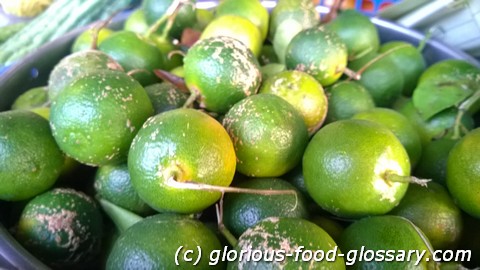Deutsch: Calamondin / Español: Calamondina / Português: Calamondim / Français: Calamondin / Italiano: Calamondino
Calamondi is another word for Calamansi or Kalamansi , the citrus fruit found in the Philippines.
Calamondin is a fruit that belongs to the citrus family, known scientifically as Citrofortunella microcarpa or × Citrofortunella mitis. This small, round citrus fruit is a hybrid, often considered a cross between a kumquat and a mandarin orange. The skin of the calamondin is thin and orange at full ripeness, closely resembling a small tangerine or mandarin in appearance. Despite its sweet-smelling exterior, the fruit's flesh is quite sour, akin to a lime or lemon, making it an excellent candidate for culinary use where acidic citrus notes are desired.
Description
The calamondin tree is highly valued for both its ornamental qualities and its fruit. Originating in China and the Philippines, it has spread across various parts of the world, particularly in Southeast Asia and the United States. The tree is small and bushy, making it suitable for container gardening and as a decorative plant in tropical and subtropical climates. Calamondin fruit is versatile in the culinary world, used fresh, preserved, or as a flavoring agent due to its unique Blend of sweetness and tartness. It's used in marmalades, preserves, and jams, as well as in beverages, marinades, and sauces. The fruit's juice is a popular substitute for lemon or lime in recipes, adding a distinct tangy flavor. In addition to its culinary uses, the calamondin is noted for its health benefits, including high vitamin C content and antioxidants.
Application Areas
In the food industry, calamondin is utilized in various ways:
- Culinary uses: The fruit is used in desserts, cocktails, and savory dishes for its acidic touch. It's particularly popular in Philippine cuisine, where it is known as "calamansi" and serves as a staple ingredient in dishes and condiments.
- Beverage preparation: Calamondin juice is a key ingredient in refreshments and cocktails, offering a unique citrus flavor.
- Preserves and condiments: The fruit is made into marmalades, jams, and preserves. It is also used in sauces and marinades, lending a citrusy Zest to meats and salads.
Well-Known Examples
- Philippine Calamansi beverages and condiments: In the Philippines, calamondin juice is widely consumed as a beverage and used as a condiment in many traditional dishes.
- Calamondin Marmalade: A popular preserve made from calamondin, showcasing the fruit's ability to blend sweet and tart flavors effectively.
Treatment and Risks
While calamondin is generally safe for consumption, its high acidity can be a concern for individuals with certain health conditions, such as acid reflux or stomach ulcers. Like other citrus fruits, it should be consumed in moderation.
Examples of Sentences
- "I added calamondin juice to the marinade to give the chicken a tangy flavor."
- "This calamondin marmalade is the perfect balance of sweet and sour."
Similar Terms or Synonyms
- Calamansi: Another name for calamondin, particularly in the Philippines.
- Miniature Orange: A colloquial term for calamondin due to its appearance.
Summary
Calamondin is a versatile citrus fruit valued for its unique flavor profile that combines elements of sweet, tangy, and sour. It's used extensively in cooking, beverages, and preserves, particularly in Southeast Asian cuisine. While calamondin is beneficial for its vitamin C and antioxidants, its acidity should be considered by those with sensitivity to citrus fruits.
--

Related Articles to the term 'Calamondin' | |
| 'Kumquat' | ■■■■■■■■■■ |
| Kumquat refers to a very small citrus fruit with the unique quality of having a sweet skin and bitter . . . Read More | |
| 'Dalanghita' | ■■■■■■■■■■ |
| Dalanghita in the food context refers to a type of citrus fruit that is widely cultivated and consumed . . . Read More | |
| 'Ugli' | ■■■■■■■■ |
| Ugli or Ugli Fruit refers to a citrus fruit native to Jamaica that is thought to be a cross between a . . . Read More | |
| 'Apricot' | ■■■■■■■■ |
| Apricot: The apricot, Prunus armeniaca, is a species of Prunus, classified with the plum in the subgenus . . . Read More | |
| 'Kalamansi / Calamansi' | ■■■■■■■ |
| Kalamansi / Calamansi: Kalamansi (Scientific name: Citrus microcarpa) refers to a small and round lime . . . Read More | |
| 'Naranga' | ■■■■■■■ |
| Naranga, commonly known as orange, is a citrus fruit with widespread popularity in the culinary world. . . . Read More | |
| 'Grapefruit' | ■■■■■■■ |
| Grapefruit is a citrus fruit known for its somewhat bitter and sour taste, making it a popular choice . . . Read More | |
| 'Kaimito / Caimito' | ■■■■■■■ |
| Kaimito / Caimito: Kaimito (Scientific name: Chrusophillum cainito) also spelled Caimito. It is called . . . Read More | |
| 'Puno ng Rambutan' | ■■■■■■■ |
| Puno ng Rambutan refers to the tree that bears the rambutan fruit, a popular tropical fruit native to . . . Read More | |
| 'Calamansi' | ■■■■■■ |
| Calamansi in the food context refers to a small, citrus fruit native to the Philippines and other Southeast . . . Read More | |
